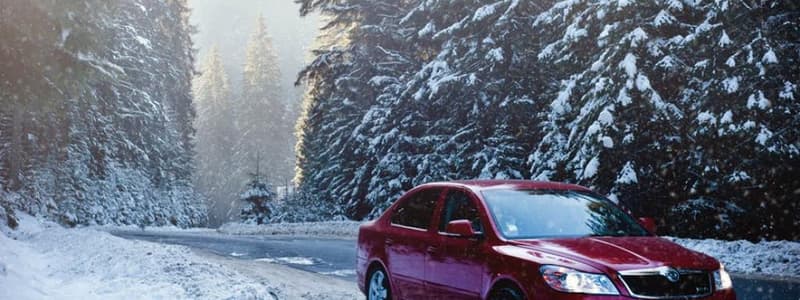Podcast
Questions and Answers
What is the correct action to take when you start to skid?
What is the correct action to take when you start to skid?
- Remove your foot from the accelerator (correct)
- Quickly apply the brakes
- Make a sharp turn in the opposite direction of the skid
- Downshift to gain speed
How should you handle a locked wheel skid caused by braking too hard?
How should you handle a locked wheel skid caused by braking too hard?
- Pump the brakes rapidly
- Turn the steering wheel in the opposite direction of the skid
- Ease up on the brake pedal while maintaining pressure to allow front wheels to roll again (correct)
- Brake even harder to try to stop the skid
What should you do to prevent skidding on slippery surfaces?
What should you do to prevent skidding on slippery surfaces?
- Avoid areas like ice patches, wet leaves, oil, or standing water (correct)
- Use the brakes aggressively
- Shift to high gear before going down a steep hill
- Make fast turns
How should you react if your vehicle has rear-wheel antilock braking system (ABS) and experiences a skid?
How should you react if your vehicle has rear-wheel antilock braking system (ABS) and experiences a skid?
What is the recommended action to take if your vehicle does not have ABS and begins to skid?
What is the recommended action to take if your vehicle does not have ABS and begins to skid?
What are some safe driving techniques to use when driving on icy or snow-covered roads?
What are some safe driving techniques to use when driving on icy or snow-covered roads?
How should you handle a sharp curve while driving?
How should you handle a sharp curve while driving?
What should you do if your vehicle starts to skid on a slippery surface?
What should you do if your vehicle starts to skid on a slippery surface?
What is one way to prevent locked wheel skids when braking?
What is one way to prevent locked wheel skids when braking?
How do anti-lock braking systems (ABS) help prevent skidding during emergency braking?
How do anti-lock braking systems (ABS) help prevent skidding during emergency braking?
What is the correct action to take if your vehicle starts to hydroplane?
What is the correct action to take if your vehicle starts to hydroplane?
Why is it important to carry snow chains for your tires in snowy areas?
Why is it important to carry snow chains for your tires in snowy areas?
What should you do if you are stuck in snow or mud?
What should you do if you are stuck in snow or mud?
How can you avoid hydroplaning when driving in wet conditions?
How can you avoid hydroplaning when driving in wet conditions?
Why is sudden braking not advisable if your vehicle starts to hydroplane?
Why is sudden braking not advisable if your vehicle starts to hydroplane?
What action should you take when parking on a sloping driveway?
What action should you take when parking on a sloping driveway?
What should you do if you experience a locked wheel skid?
What should you do if you experience a locked wheel skid?
What is the correct way to handle a sharp curve while driving?
What is the correct way to handle a sharp curve while driving?
What is a key safety tip for driving on slippery surfaces?
What is a key safety tip for driving on slippery surfaces?
When should you use anti-lock brakes system (ABS)?
When should you use anti-lock brakes system (ABS)?
Flashcards are hidden until you start studying
Study Notes
Skidding and Emergency Responses
- When starting to skid, remain calm and avoid abrupt maneuvers.
- If experiencing a locked wheel skid from hard braking, gently release the brake to regain traction.
- Prevent skidding on slippery surfaces by reducing speed and maintaining a safe following distance.
- In a rear-wheel antilock braking system (ABS) equipped vehicle, apply the brakes firmly but maintain control of the steering.
- For vehicles without ABS, gently pump the brakes to avoid locking the wheels and maintain steering control.
Driving on Snow and Ice
- Use gentle maneuvers and avoid rapid acceleration or deceleration on icy or snow-covered roads.
- When handling a sharp curve, slow down before entering the turn and then accelerate gradually out of the curve.
- If skidding on a slippery surface, steer in the direction of the skid to regain control.
- To prevent locked wheel skids while braking, apply brakes gently and progressively.
Anti-lock Braking Systems (ABS)
- ABS helps prevent skidding during emergency stops by automatically modulating brake pressure.
- If hydroplaning occurs, ease off the accelerator and steer straight until traction is regained.
- Carrying snow chains in snowy areas enhances traction and helps prevent vehicle slippage.
Getting Unstuck and Hydroplaning Prevention
- If stuck in snow or mud, straighten the wheels and gently accelerate to create momentum. Avoid spinning the wheels.
- Hydroplaning can be avoided by reducing speed in wet conditions and ensuring proper tire tread depth.
- Sudden braking while hydroplaning can cause loss of control; it’s best to ease off the throttle.
- When parking on a sloping driveway, turn the wheels towards the curb to prevent rolling.
Overall Safety Tips
- Use anti-lock brakes when needing to stop quickly in an emergency; apply steady pressure until stopped.
- On slippery surfaces, keep a safe distance from other vehicles and drive at lower speeds to maintain control.
Studying That Suits You
Use AI to generate personalized quizzes and flashcards to suit your learning preferences.




